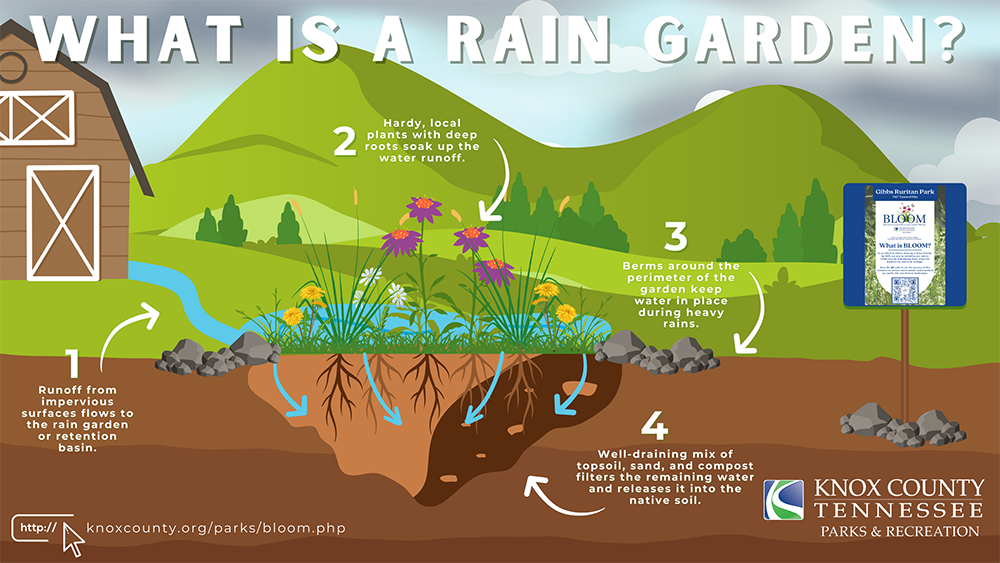
At Knox County Parks and Rec, we have created a new initiative to reduce our Carbon Footprint and make even more beautiful and functional spaces for our community.
This new initiative is called BLOOM - which stands for Beautifying Local Outdoor Spaces withOut Mowing.
This program will reduce mowing by 25%, which cuts carbon emissions, builds organic soil matter, and even enhances pollinating habitats for bees.
We will eliminate invasive species, restoring the balance of nature, and eradicating plants that damage our native ecosystem.
By planting greenery that is native to our local geographical area, we increase air quality and give the plants an environment to thrive.
John Tarleton Park Planting Day October 2023: Phase One
Beverly Park Planting Day October 2023: Phase One
Gibbs Ruritan Park Tree Planting Day January 2024: Phase One
BLOOM Native Plants
John Tarleton Park in BLOOM – August 2024
John Tarleton Park – One Year in BLOOM
What is a Rain Garden?

A rain garden is a shallow, planted depression that is designed to capture and infiltrate stormwater runoff from impervious surfaces such as roofs, streets, driveways, parking lots, and areas with compacted soil. Rain gardens incorporate water-loving plants, mulch, and permeable soil that enhance the infiltration of stormwater into the ground, providing an alternative approach to piped or paved drainage systems.
Why install a Rain Garden?
A rain garden is a beautiful, functional way to improve drainage and water quality on your property. Through capture and infiltration, rain gardens help slow down stormwater runoff and filter out pollutants commonly contained within stormwater, like fertilizers, sediment, and pathogens, preventing them from entering our waterways. In this way, rain gardens can mitigate actively eroding areas in your yard while enhancing its visual appeal.
Rain gardens not only reduce erosion and localized flooding, they also enrich the charm and attractiveness of your yard and neighborhood. Rain gardens are a landscaping amenity that add beauty and value to a property. By populating your rain garden with native shrubs and flowers, you will attract local pollinators and other wildlife that rely on native plants for food and habitat. Native plants will generally tolerate local climate conditions better than non-native species and can be selected for your specific site conditions (shady vs. sunny; water-loving vs. water-averse).
Rain Garden at Gibbs Ruritan Park
Gibbs Ruritan Park is located in the headwaters of the Beaver Creek Watershed, meaning that any water that drains through the park eventually joins other tributaries to become the start of Beaver Creek. Headwaters are important to protect because they supply the organic material that contributes to the growth and productivity of many organisms downstream, including insects and fish. Healthy headwaters also help to keep sediment and pollutants out of the stream’s lower reaches. Our installation of the rain garden at Gibbs Ruritan Park is a long-term investment by the Knox County Parks & Recreation BLOOM Committee toward a cleaner and more resilient Beaver Creek.


